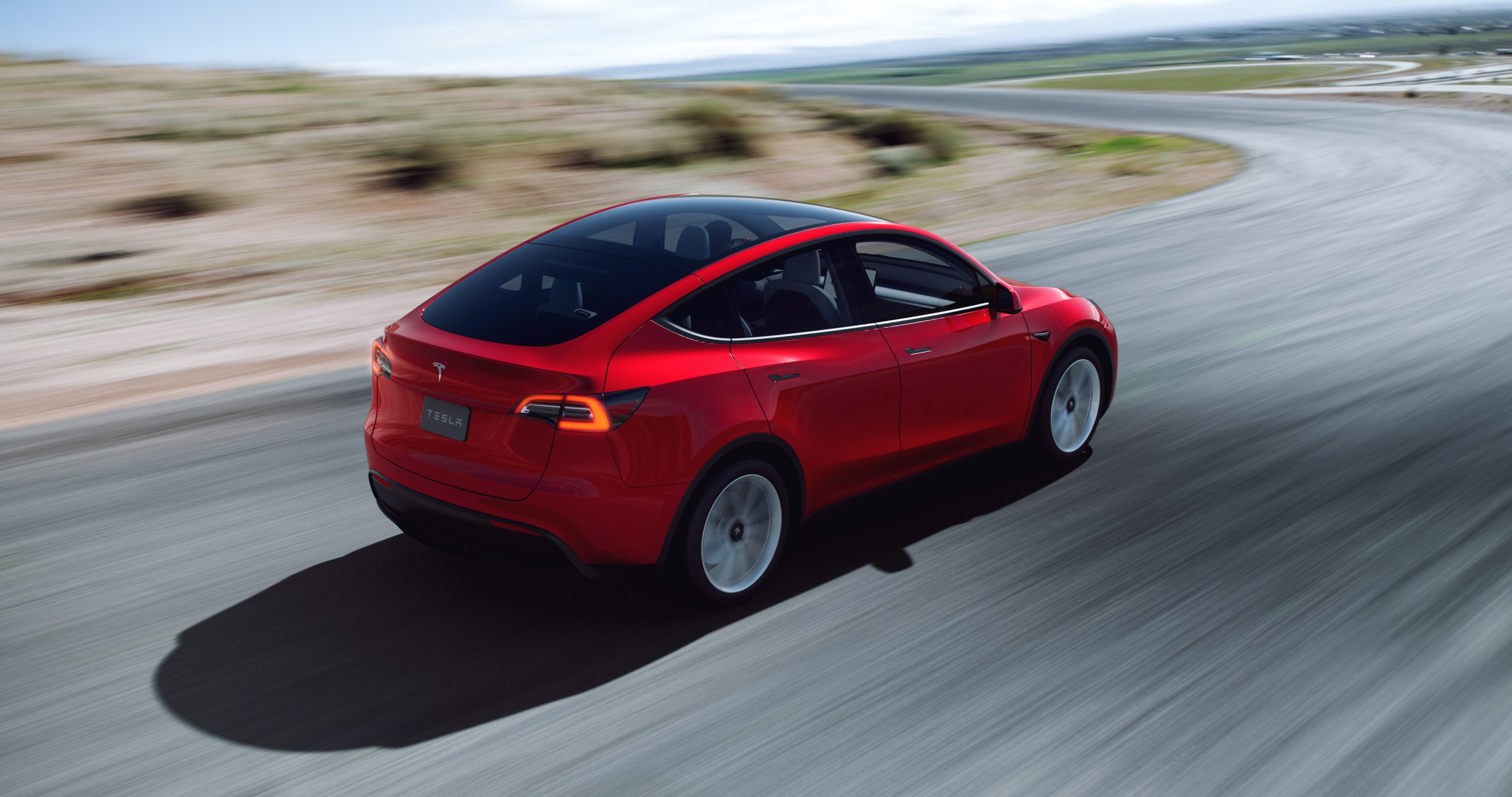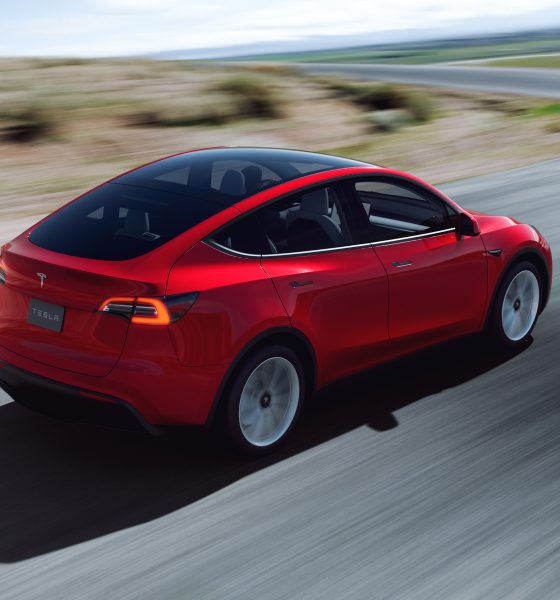

News
Tesla’s launch of Model Y RWD is the nail in the coffin at the worst time for legacy auto
Tesla’s launch of the Model Y Rear-Wheel-Drive (RWD) comes at perhaps the worst time for legacy automotive companies. It is affordable, comparable to similar models from competitors, and is perhaps the nail in the coffin, especially for the U.S. market, as it is an affordable car that features some of the best add-ons that EV buyers could need.
Last night, Tesla launched the Model Y RWD on its website, and with federal and local incentives, it could cost buyers under $31,000 as it qualifies for the full EV tax credit from the government. Packing the LFP, or lithium iron phosphate battery pack, Tesla has brought its most popular car to an affordable level with reasonable range ratings and more than acceptable performance metrics.
While it was a timely offering in terms of Tesla’s trek for 1.8 million deliveries this year after a lackluster Q3 due to factory upgrades that required production pauses, this vehicle offers the automaker two things:
- A new mode of demand for the Model Y, especially in the U.S. market, where it has already been extremely popular
- Another edge over the already-frustrated competition, which is falling further behind due to a number of factors, and has already thrown in the towel to Tesla and will use its Superchargers next year because developing infrastructure is difficult
Of course, the Model Y RWD is not the best crossover out there. We would likely reserve this for the Long Range version of the Model Y, which offers more travel distance per charge and better performance metrics.
That’s not to say that the Model Y RWD is something worth overlooking because, for many, it is the answer to the question they’ve had: how will I put the most popular EV in the U.S. in my driveway for roughly $35,000?
This was Tesla’s answer.
Obviously, there is no shortage of people who are at least thinking about buying an EV. Recent figures have shown that Tesla commands the U.S. EV market by a considerable margin, and although it seems there is still plenty of demand for its vehicles in the North American market, Tesla still has to find ways to cater to customers who need certain vehicles at certain price points.
The Long Range Model Y is an ideal car for most people and families. Crossovers are an extremely sought-after body style in this market, but they come at a price. Give someone who needs a crossover EV at a price they cannot pass up and pack on the world’s most expansive charging network on top of it, and it is simply not a matter of whether people will buy it. It’s a matter of when, and how many will be bought.
It is no secret that people may be somewhat worried that Tesla may not reach its 1.8 million unit delivery goal for the year. Even with the Model 3+, or Highland, whatever you want to call it, starting deliveries this month in Europe, Asia, and the Middle East and the Cybertruck likely beginning deliveries soon, there still needs to be some movement in the U.S. market.
Cybertruck deliveries are likely going to be somewhat small for the last quarter of the year, and Highland will contribute plenty of units to the Q4 figures, but the U.S. is still where Tesla dominates the most, but neither of these vehicles are available here yet.
Enter the Model Y RWD as the nail in the coffin for companies that are either striking due to UAW demands for better wages and benefits, or are struggling with EV software and quality, or just an overall lack of awareness in terms of the auto market.
Yes, there are some people out there that have no interest in an EV. However, there are plenty that are. Ford, GM, and Stellantis are not building any in the U.S. currently because of the UAW strike, Volkswagen may have some things to offer, but it hasn’t chosen to adopt the NACS charging connector to gain access to the Supercharger network. Hyundai is still early in its EV venture, and the IONIQ is certainly an attractive option, but the Model Y RWD will trump it because of its price and Tesla’s overall advantages, including charging and overall EV prowess.
We have talked plenty about nails in the coffin for EV makers before, but with a new demand trigger with the Model Y RWD for Tesla and Detroit pausing EV production while the terms of a new UAW contract get worked out, this is spelling nothing but trouble for Tesla’s competitors.
The Model Y RWD has opened a new can of worms for competitors to try and combat. Right now, at least in the U.S., it’s Tesla’s world, and competitors are just living in it.
I’d love to hear from you! If you have any comments, concerns, or questions, please email me at joey@teslarati.com. You can also reach me on Twitter @KlenderJoey, or if you have news tips, you can email us at tips@teslarati.com.

News
Tesla FSD fleet is nearing 7 billion total miles, including 2.5 billion city miles
As can be seen on Tesla’s official FSD webpage, vehicles equipped with the system have now navigated over 6.99 billion miles.

Tesla’s Full Self-Driving (Supervised) fleet is closing in on almost 7 billion total miles driven, as per data posted by the company on its official FSD webpage.
These figures hint at the massive scale of data fueling Tesla’s rapid FSD improvements, which have been quite notable as of late.
FSD mileage milestones
As can be seen on Tesla’s official FSD webpage, vehicles equipped with the system have now navigated over 6.99 billion miles. Tesla owner and avid FSD tester Whole Mars Catalog also shared a screenshot indicating that from the nearly 7 billion miles traveled by the FSD fleet, more than 2.5 billion miles were driven inside cities.
City miles are particularly valuable for complex urban scenarios like unprotected turns, pedestrian interactions, and traffic lights. This is also the difference-maker for FSD, as only complex solutions, such as Waymo’s self-driving taxis, operate similarly on inner-city streets. And even then, incidents such as the San Francisco blackouts have proven challenging for sensor-rich vehicles like Waymos.
Tesla’s data edge
Tesla has a number of advantages in the autonomous vehicle sector, one of which is the size of its fleet and the number of vehicles training FSD on real-world roads. Tesla’s nearly 7 billion FSD miles then allow the company to roll out updates that make its vehicles behave like they are being driven by experienced drivers, even if they are operating on their own.
So notable are Tesla’s improvements to FSD that NVIDIA Director of Robotics Jim Fan, after experiencing FSD v14, noted that the system is the first AI that passes what he described as a “Physical Turing Test.”
“Despite knowing exactly how robot learning works, I still find it magical watching the steering wheel turn by itself. First it feels surreal, next it becomes routine. Then, like the smartphone, taking it away actively hurts. This is how humanity gets rewired and glued to god-like technologies,” Fan wrote in a post on X.
News
Tesla starts showing how FSD will change lives in Europe
Local officials tested the system on narrow country roads and were impressed by FSD’s smooth, human-like driving, with some calling the service a game-changer for everyday life in areas that are far from urban centers.

Tesla has launched Europe’s first public shuttle service using Full Self-Driving (Supervised) in the rural Eifelkreis Bitburg-Prüm region of Germany, demonstrating how the technology can restore independence and mobility for people who struggle with limited transport options.
Local officials tested the system on narrow country roads and were impressed by FSD’s smooth, human-like driving, with some calling the service a game-changer for everyday life in areas that are far from urban centers.
Officials see real impact on rural residents
Arzfeld Mayor Johannes Kuhl and District Administrator Andreas Kruppert personally tested the Tesla shuttle service. This allowed them to see just how well FSD navigated winding lanes and rural roads confidently. Kruppert said, “Autonomous driving sounds like science fiction to many, but we simply see here that it works totally well in rural regions too.” Kuhl, for his part, also noted that FSD “feels like a very experienced driver.”
The pilot complements the area’s “Citizen Bus” program, which provides on-demand rides for elderly residents who can no longer drive themselves. Tesla Europe shared a video of a demonstration of the service, highlighting how FSD gives people their freedom back, even in places where public transport is not as prevalent.
What the Ministry for Economic Affairs and Transport says
Rhineland-Palatinate’s Minister Daniela Schmitt supported the project, praising the collaboration that made this “first of its kind in Europe” possible. As per the ministry, the rural rollout for the service shows FSD’s potential beyond major cities, and it delivers tangible benefits like grocery runs, doctor visits, and social connections for isolated residents.
“Reliable and flexible mobility is especially vital in rural areas. With the launch of a shuttle service using self-driving vehicles (FSD supervised) by Tesla in the Eifelkreis Bitburg-Prüm, an innovative pilot project is now getting underway that complements local community bus services. It is the first project of its kind in Europe.
“The result is a real gain for rural mobility: greater accessibility, more flexibility and tangible benefits for everyday life. A strong signal for innovation, cooperation and future-oriented mobility beyond urban centers,” the ministry wrote in a LinkedIn post.
News
Tesla China quietly posts Robotaxi-related job listing
Tesla China is currently seeking a Low Voltage Electrical Engineer to work on circuit board design for the company’s autonomous vehicles.

Tesla has posted a new job listing in Shanghai explicitly tied to its Robotaxi program, fueling speculation that the company is preparing to launch its dedicated autonomous ride-hailing service in China.
As noted in the listing, Tesla China is currently seeking a Low Voltage Electrical Engineer to work on circuit board design for the company’s autonomous vehicles.
Robotaxi-specific role
The listing, which was shared on social media platform X by industry watcher @tslaming, suggested that Tesla China is looking to fill the role urgently. The job listing itself specifically mentions that the person hired for the role will be working on the Low Voltage Hardware team, which would design the circuit boards that would serve as the nervous system of the Robotaxi.
Key tasks for the role, as indicated in the job listing, include collaboration with PCB layout, firmware, mechanical, program management, and validation teams, among other responsibilities. The role is based in Shanghai.
China Robotaxi launch
China represents a massive potential market for robotaxis, with its dense urban centers and supportive policies in select cities. Tesla has limited permission to roll out FSD in the country, though despite this, its vehicles have been hailed as among the best in the market when it comes to autonomous features. So far, at least, it appears that China supports Tesla’s FSD and Robotaxi rollout.
This was hinted at in November, when Tesla brought the Cybercab to the 8th China International Import Expo (CIIE) in Shanghai, marking the first time that the autonomous two-seater was brought to the Asia-Pacific region. The vehicle, despite not having a release date in China, received a significant amount of interest among the event’s attendees.








